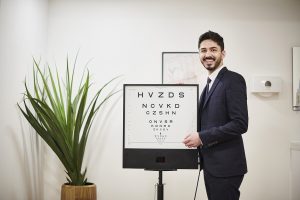At what prescription do you become legally blind?
You might think that recognising whether you are blind is a simple thing. I mean, if you can’t see anything beyond your nose – that should give you a hint, right? Or the fact that your glasses and lenses have become a lifeline that you can’t do without.
While these are telltale signs that something isn’t right, nothing is ever that simple – least of all your vision.
Our eyes are one of the most complex systems in the whole of our bodies – maybe, even in the whole known universe. As such, there are as many types and degrees of vision as there are shades of colours you can see (that’s approximately 100 million!). The result? Knowing whether or not you would qualify as legally blind can be more difficult than you might think.
Being Registered Blind in the UK
Around 2 million people in the UK are living with some level of sight loss – whether that be due to long-sightedness, short-sightedness, or astigmatism. Approximately 360,000 of them are also registered as legally blind or partially sighted.
To be registered as blind or partially blind, patients have to undergo various scans and measurements with an eye specialist or “consultant opthalmologist”. This process is designed to determine whether you meet the Royal National Institute of Blind People (RNIB)‘s criteria for certification of blindness or partial blindness.
These examinations will assess the clarity or sharpness of your vision (visual acuity) and the quality of your visual field, including peripheral vision. The results of these two tests are then combined to determine whether you meet the criteria.
This is where things get a little more complicated. If you score well on one test, the other aspect of your vision would need to be significantly poor for you to qualify as blind.
For example, if you have a good visual acuity, your visual field will have to be severely compromised. Similarly, if you have all your visual field, your visual acuity will need to be very limited to meet the RNIB criteria for certification.
Figuring out if you are blind or partially sighted
Clearly, knowing yourself whether you would qualify as blind or partially sighted is no easy feat. However, finding out is a well-established and straightforward process.
The first of the vision tests that will be performed by your consultant opthalmologist is the familiar Snellen Test. This is commonly used to test your visual acuity and, if you have ever been to an optician’s, you will likely have had one before.
The Snellen Test involves reading rows of increasingly smaller black letters on a white chart. The average standard of visual acuity is 6/6. This means that you can read all, or most, of the chart from six metres away; this acts as the standard on which all other measurements are based.
For instance, if you can only read the top line of the chart, your visual acuity would be 6/60 — i.e. you can see at six metres what someone with standard vision can see at 60 metres. A visual field test is more interactive. Typically, the ophthalmologist will cover one of your eyes, ask you to focus on a target object, and pose questions about what you can see on the far edges and periphery of your vision.
Your Results
With the results from your visual acuity and visual field tests — which are performed while wearing your glasses or contacts — the eye specialist will determine if you are severely sight impaired or blind. This will depend on whether your results fall within one of the following categories (as outlined on the RNIB website):
- Visual acuity of less than 3 / 60 with a full visual field.
- Visual acuity between 3 / 60 and 6 / 60 with a severe reduction of field of vision, such as tunnel vision.
- Visual acuity of 6 / 60 or above but with a very reduced field of vision, especially if a lot of sight is missing in the lower part of the field.
The following categories are used to determine if you are sight impaired or partially sighted:
- Visual acuity of 3 / 60 to 6 / 60 with a full field of vision.
- Visual acuity of up to 6 / 24 with a moderate reduction of field of vision or with a central part of vision that is cloudy or blurry.
- Visual acuity of 6 / 18 or even better if a large part of your field of vision, for example, a whole half of your vision, is missing or a lot of your peripheral vision is missing.
But that’s not all. You may not qualify if you only have poor vision in one of your eyes, your sight loss is temporary, or if you are currently receiving treatment that could improve your vision.
The bottom line is if you are concerned about the quality of your vision or think that you might be partially sighted, it’s worth getting a referral from your GP or going directly to an expert ophthalmologist to figure out exactly what’s what.
This will give you peace of mind and certainty regarding your level of vision. Once you know that, you can begin to explore potential treatment options – a process that could be surprisingly positive – if you contact the right clinic that can safely treat very high prescriptions.
If you would like to find out more, speak to one of our friendly Clinic Coordinators or Book a Consultation today.


